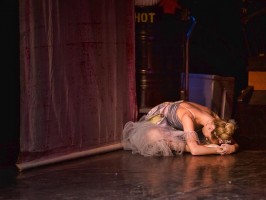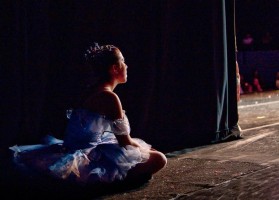How do you approach a student who has been diagnosed with a chronic illness?
How do you help a student who has a serious injury and cannot dance, or is out-of-action for a long time still waiting to be diagnosed?
This article focuses on practical and emotional considerations when teaching students dealing with chronic illness, long-term injuries and extended rehabilitation periods.
First Reactions
First and foremost, don’t panic. They are the same person they were yesterday, and likely do not want to be treated differently. Practical accommodations may have to be made, but these ought to be managed with utmost professionalism and minimal fuss, but still with a compassionate manner and sensitive approach.
When discussing the situation privately with the student:
- Be supportive and friendly, but don’t mollycoddle or patronise
- Be approachable and talk openly about the situation, but don’t be casual, blunt or make hasty judgments (“Yes, it is unlikely you will ever dance again, but we will work with what we have”)
- Be sympathetic and give them space for their emotions (“It is natural you will feel very upset”)
- Do not display or give prescience to your own fears (“I was so scared for you when I heard, it’s tragic”)
- Focus on the positive and what your collective plan of action will be
- Do not make promises you cannot keep
The latter two points are of particular extreme importance if the condition is degenerative, or if their prognosis is still unknown. Whatever the situation it is vital you remain positive but do not make judgments about their future or make promises you cannot keep.
Statements such as “you will still be able to dance professionally if you keep working for it” or “I know you’ll get better” can be very dangerous – you are not in a position to make such guarantees.
Don’t forget to ask:
- Ask for information about exactly how their illness/injury will or may impact on their physical and/or cognitive abilities, including if their symptoms fluctuate – do not be afraid to ask what you need to know to teach this student effectively
- Check with the student or their parents if they require any medication or will have to use any aids (such as splints, braces or support bandages) during classes, and if they are able to manage this independently or require your help
- Check if an additional teaching assistant will be required for one-on-one support, particularly if the student is younger, or if they will require any other specialised assistance
- Check with the student if they would rather their classmates knew what is going on or not, and, if the latter, discuss what might be appropriate to say to their peers to explain student differentiation (and if they would like the teacher to tell them or to make an announcement themselves)
Don’t be afraid to say you are unable to accommodate a student if their health has deteriorated beyond your abilities or expertise, or if you think it is no longer safe for them to dance at all – apologise in a professional and courteous manner but stand firm if you don’t feel you can safely tutor the student.
When the student is in class:
- Do make provisions to accommodate physical limitations but do not overindulge or openly draw attention to differing expectations – that is between you and the student only
- Do not single them out or draw attention to their illness (e.g. “Are you managing alright over there? I’m worried you’ll overdo it”), but ensure they are equally not ignored or segregated
- Be mindful about offering corrections in view of any physical limitations, but do not let them get away with laziness or a bad attitude – they should follow the rules like everyone else
- Make sure they know they can approach you if they need help or advice at any time but that they need to take responsibility for their own learning – only they know what they can manage

Managing Time Out
Observing Classes:
Many teachers will insist that dancers observe any class they miss, regardless. However, for students who are off for very long periods this process can be extremely demoralising and entirely unproductive; not only do they commonly learn very little from the experience, but watching their peers gain in strength and proficiency while they in turn grow weaker and less capable is beyond disheartening. Decide on a case-by-case basis what classes may and may not be genuinely beneficial for the dancer to observe, rather than decree compulsory attendance for all.
Set Alternative Tasks:
Whether to replace missed classes, or as a proactive moral-boosting task in its own right, set the dancer alternative study options. If they are stuck at home or in hospital for a while this is particularly beneficial. Encourage them to watch ballets and musicals and familiarize themselves with works they do not know. Set them assignments to research the elements of dance history, to listen to the music of famous repertoire or to plan lessons for some of your younger students. Choose something you think will prick their interest whilst simultaneously contributing to their overall dance education. Not only will such activity-setting provide a positive distraction from their situation, but will help the dancer feel that they are still valued, and have not been forgotten.
Two-Way Communication:
Keep channels of communication open between you, the student, their parents, and where appropriate, their doctor. Particularly if they have to go home or to hospital for a few weeks or months, keep contact to once-a-week minimum if they are on a vocational or pre-vocational programme, and at least once a month if they are a recreational student. This contact helps reassure the student that, providing they are well enough, there is still room for them to return.
Once a student has returned to dance, an open dialogue must be maintained – consult dancers about what you think is the best path for them and listen to their thoughts. Don’t arbitrarily make decisions about their training or their future without discussing it with them first.
Rehabilitation
Avoid Demotion:
Do not drop a student down a class/level unless in the most unavoidable circumstances. Not only might this action be incredibly detrimental to their morale, but in turn this could lead to depression, or resulting in them wanting to abandon dance altogether. Instead, try to offer alternative solutions such as:
- Offer them private rehabilitation classes to rebuild their strength/stamina/technique/flexibility etc. in a safe environment where they can build up their physical skills and their confidence before they return to their normal classes,
- If they are learning an examination syllabus, get them a copy of video footage and the syllabus notes so they can study from home and/or in their own time in preparation for retuning,
- Let them watch classes that interest them or where they can learn significantly from observation, such as pas de deux classes, whether or not they can take part at that stage.
Personalised Programmes:
If a dancer has been off for a while, is missing lots of classes, or requires additional support, work with them, their parents and their doctor (if appropriate) to coordinate a personalised rehabilitation/maintenance plan. Ideally also consult a physiotherapist or dance rehabilitation therapist if available. As a team coordinate a suitable timetable of dance classes, body conditioning classes and specialist classes (such as Pilates, Floor Barre, Yoga, Gyrotonics, Alexander Technique), in order to provide a balanced programme specifically designed for the student’s unique requirements.
By offering personalised plans, dancers in recovery are able to more quickly return to their optimum performance and it also helps them keep up with their peers. For dancers who require long-term support or who suffer from a degenerative illness, such supplementary training can help decrease their ‘down time’ and extend the longevity of their dancing lives.
Returning to Class
Develop a Code:
When a dancer is returning after being off for a long while, or after a diagnosis of a serious condition, organise a meeting before their first class to decide on a code for subtle communication. For instance, ‘red’ = “bad day, lots of pain, might need to leave in the middle”, ‘amber’ = “not great, might need to rest lots during class”, and ‘green’ = “good day, don’t hold back on corrections today”. This way, students can effectively communicate their health status that day to the teacher without drawing attention to themselves, their illness/injury, or openly broadcasting it in front of the class. Not only is this system far less embarrassing for self-conscious students, but it is very time efficient.
Resting During Class:
Have a private talk with the student outside of class time to explain that you are accepting of the fact they may need to take short rests in the middle of exercises or miss out some exercises entirely. Reaffirm that you do not have a problem with this, and they do not need to ask permission during class to miss sections, but that you expect they will manage themselves responsibly. If the issue is with stamina, make the student aware that if they miss out the same exercises each class they may need to do additional conditioning exercises to prevent muscular imbalances, or additional sessions to learn missed set exercises at a later date. To avoid this they should be mindful to take rests at different points each lesson if possible.

Exercise Modification:
Some dancers may need you to help them modify exercises so they are able to perform them, and this is usually preferable to them missing them entirely. For example, they may need to take développés to 45° only instead of 90°, or do 4 demi-pliés instead of 2 demi-pliés and 1 grand plié. Organise a private session to talk through appropriate modifications they can add-in when necessary, rather than discuss their personalised versions in front of the class. Be sensitive to their requirements and listen to their feedback during this time so you work as a team to find the best solutions.
Class Corrections:
Be mindful that some dancers will know what to do, but their bodies simply will not let them do it. For these dancers it is incredibly frustrating to be continually corrected on a technical fault when they are physically unable to improve upon it, and it can make them feel stupid and ‘picked on’. If you know a dancer has a chronic illness/injury it is usually more productive to ask them questions to determine whether their problem is physical or cerebral before offering a correction, or to simply call out general class reminders instead.
Inappropriate Punishment:
Despite the passed-down dancers’ ‘mantra of martyrdom’ to suffer through anything and ‘never give in’, this can be an extremely dangerous practice and can cause serious long-term consequences for the dancer who is chronically ill or injured in particular. Do not punish these dancers or goad them into making dangerous choices by making comments such as “well, if you can’t be bothered to push through and make an effort you aren’t worth my time”, or “all true dancers work through anything”.
Similarly, when a dancer is recovering from a long period away from dance or physical activity remember that they will need time to rebuild their strength, agility, coordination and confidence. To ‘get their dance legs back’ as it were. Do not disgrace or admonish them in front of their classmates, shout at them or attack their efforts, or compare them to their healthy peers. The psychological and emotional consequences of such actions can be devastating.
Instead be patient, supportive, and acknowledge the importance (and offer praise for) small improvements, accomplishments and progress. Remember, the student is there because they want to learn and to recover their form and will, in all probability, already be pushing themselves as much as they dare.

Performances & Dance Exams
Shows & Performance Casting:
If you have allocated the student with a chronic illness a part and they then start missing rehearsals due to ill health, don’t automatically pull them out or replace them with another dancer. Not only can this be demoralising, but it can greatly impact their self-esteem and may even cause a deterioration in their symptoms. Instead have a gentle talk with them suggesting you assign an understudy to cover their part, the same as in professional companies, so that they can focus exclusively on their choreography rather than worry about whether or not they will manage the performance. This in itself may actually alleviate stress, improve symptoms and increase their chances of performing on the night, but is also a more positive way of managing the situation and provides a safety net for all concerned.
Dance Examinations:
If the student is missing a great deal of classes and are very much behind their peers, or their health fluctuates greatly, invite the student and their parents to an informal meeting during which you can state your concerns and encourage the dancer to discuss how they feel about the situation. As a team you can negotiate the best course of action, whether that be to put them in for the exam knowing the fees may be lost if they are too unwell to manage it on the day, or if they would rather move up and skip this exam, or stay and join the upcoming class.
By talking openly and involving the dancer in decisions about their training and their future they will likely feel more content with and accepting of any decisions made.
Emotional Turmoil & Changing Futures
The Impact of Chronic Illness:
Do not underestimate the emotional complexity of dealing with a chronic illness. Even if you are extremely empathic, do not assume you completely understand their situation unless you have had a similar experience. It is very different from experiencing an injury. Depending on exactly what their diagnosis is, and what their prognosis is, the dancer may be experiencing a vast array of complex emotional turmoil as they grow to come to terms with their situation.
“Will I ever Dance Again?”:
While each situation offers a unique emotional experience for the dancer, both those with chronic illnesses and those who are seriously injured will share some challenging psychological and emotional issues. One common between both is the often experienced grief and torment of not knowing if they will recover sufficiently to be able to dance again, or to the level they aspire to. They may be having to adjust their expectations and plans for the future – possibly having to deal with the fact they will now be unable to dance professionally. This process of adjustment can be tortuous for some, and can lead to depression and long-term issues if they are not provided the support they need when they are vulnerable.

Displays of Emotion:
Considering the student’s mindset and circumstances, they may experience and display a wide range of emotions, including anxiety, depression, apathy, withdrawal or even explosive anger. Dance schools and teachers need to expect, support and allow for these emotional reactions. You, as the teacher, need to learn to not take any outbursts or negative behaviour personally and to remain understanding, but still take a firm approach to inappropriate conduct.
Pastoral Care:
Many teachers appear to be fearful that it is somehow unprofessional or inappropriate to engage with students on personal matters, particularly if they are advanced students in full-time training. Yet this approach separates appropriate and often needed pastoral care from the business of dancing; the result being that dance is seen as unconnected with the welfare and development of the student, and dancers grow to believe they are disposable, and are valueless if unable to perform.
Remember, in many situations the simple act of listening with warmth and attention will offer the student the support they require.
Dancers with chronic illness or long-term injury are vulnerable and require teachers who are considerate, gentle and caring, but overall, extremely patient and compassionate. They need teachers who will guide them through extremely difficult periods by helping them set positive realistic goals and who will help them achieve them. They want to be met with authoritative reassurance, and not sense your fear for them or that you have stopped caring about them. They need to be reassured, and not left to feel isolated or abandoned.
As professional and responsible educators it is our duty, and indeed privilege to provide for the students in our care.
Every effort has been made to ensure the accuracy and relevance of the information provided in this article, and the content has been carefully considered. Please read this disclaimer.
Teachers: If you do not feel sufficiently qualified, or are in any doubt as to how to assist dancers with illness, injury, or in developing dance-specific rehabilitation programmes, seek expert advice and/or liaise with the dancer’s physician.
Angeline Lucas is a freelance dance writer, teacher and lecturer based in England. She has been awarded Registered Teacher Status with the Royal Academy of Dance (RAD) and is an Approved Teacher of the Council for Dance Education & Training (CDET). Angeline trained at Northern Ballet School (NBS) and holds a Certificate of Higher Education in Dance Education, validated by RAD and the University of Surrey. Previous roles have included working as head of department, outreach coordinator and curriculum manager, and she also has experience in dance research and arts administration. Angeline has taught and lectured at various private dance studios, schools, colleges and on community programmes, and is considered to be a dedicated, experienced and enthusiastic teacher. Angeline’s greatest passion is classical ballet, and is devoted to the advancement of the art form, the promotion of accessible high-standard dance education, and facilitating the achievement of her students.


